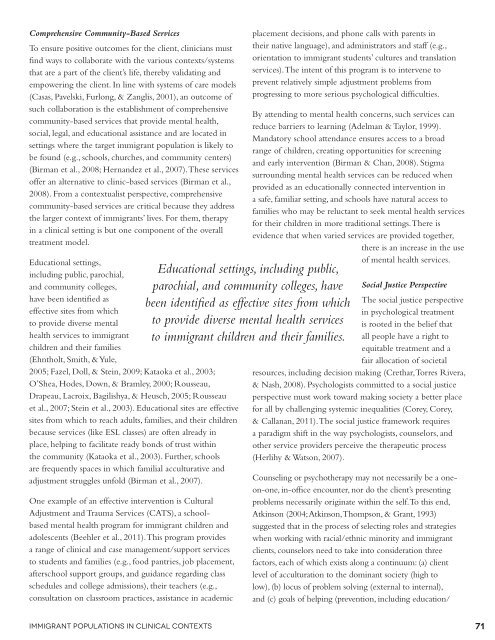Crossroads: The Psychology of Immigration in the New Century
Crossroads: The Psychology of Immigration in the New Century
Crossroads: The Psychology of Immigration in the New Century
Create successful ePaper yourself
Turn your PDF publications into a flip-book with our unique Google optimized e-Paper software.
Comprehensive Community-Based Services<br />
To ensure positive outcomes for <strong>the</strong> client, cl<strong>in</strong>icians must<br />
f<strong>in</strong>d ways to collaborate with <strong>the</strong> various contexts/systems<br />
that are a part <strong>of</strong> <strong>the</strong> client’s life, <strong>the</strong>reby validat<strong>in</strong>g and<br />
empower<strong>in</strong>g <strong>the</strong> client. In l<strong>in</strong>e with systems <strong>of</strong> care models<br />
(Casas, Pavelski, Furlong, & Zanglis, 2001), an outcome <strong>of</strong><br />
such collaboration is <strong>the</strong> establishment <strong>of</strong> comprehensive<br />
community-based services that provide mental health,<br />
social, legal, and educational assistance and are located <strong>in</strong><br />
sett<strong>in</strong>gs where <strong>the</strong> target immigrant population is likely to<br />
be found (e.g., schools, churches, and community centers)<br />
(Birman et al., 2008; Hernandez et al., 2007). <strong>The</strong>se services<br />
<strong>of</strong>fer an alternative to cl<strong>in</strong>ic-based services (Birman et al.,<br />
2008). From a contextualist perspective, comprehensive<br />
community-based services are critical because <strong>the</strong>y address<br />
<strong>the</strong> larger context <strong>of</strong> immigrants’ lives. For <strong>the</strong>m, <strong>the</strong>rapy<br />
<strong>in</strong> a cl<strong>in</strong>ical sett<strong>in</strong>g is but one component <strong>of</strong> <strong>the</strong> overall<br />
treatment model.<br />
Educational sett<strong>in</strong>gs,<br />
<strong>in</strong>clud<strong>in</strong>g public, parochial,<br />
and community colleges,<br />
have been identified as<br />
effective sites from which<br />
to provide diverse mental<br />
health services to immigrant<br />
children and <strong>the</strong>ir families<br />
(Ehntholt, Smith, & Yule,<br />
2005; Fazel, Doll, & Ste<strong>in</strong>, 2009; Kataoka et al., 2003;<br />
O’Shea, Hodes, Down, & Bramley, 2000; Rousseau,<br />
Drapeau, Lacroix, Bagilishya, & Heusch, 2005; Rousseau<br />
et al., 2007; Ste<strong>in</strong> et al., 2003). Educational sites are effective<br />
sites from which to reach adults, families, and <strong>the</strong>ir children<br />
because services (like ESL classes) are <strong>of</strong>ten already <strong>in</strong><br />
place, help<strong>in</strong>g to facilitate ready bonds <strong>of</strong> trust with<strong>in</strong><br />
<strong>the</strong> community (Kataoka et al., 2003). Fur<strong>the</strong>r, schools<br />
are frequently spaces <strong>in</strong> which familial acculturative and<br />
adjustment struggles unfold (Birman et al., 2007).<br />
One example <strong>of</strong> an effective <strong>in</strong>tervention is Cultural<br />
Adjustment and Trauma Services (CATS), a schoolbased<br />
mental health program for immigrant children and<br />
adolescents (Beehler et al., 2011). This program provides<br />
a range <strong>of</strong> cl<strong>in</strong>ical and case management/support services<br />
to students and families (e.g., food pantries, job placement,<br />
afterschool support groups, and guidance regard<strong>in</strong>g class<br />
schedules and college admissions), <strong>the</strong>ir teachers (e.g.,<br />
consultation on classroom practices, assistance <strong>in</strong> academic<br />
Immigrant Populations <strong>in</strong> Cl<strong>in</strong>ical Contexts<br />
Educational sett<strong>in</strong>gs, <strong>in</strong>clud<strong>in</strong>g public,<br />
parochial, and community colleges, have<br />
been identified as effective sites from which<br />
to provide diverse mental health services<br />
to immigrant children and <strong>the</strong>ir families.<br />
placement decisions, and phone calls with parents <strong>in</strong><br />
<strong>the</strong>ir native language), and adm<strong>in</strong>istrators and staff (e.g.,<br />
orientation to immigrant students’ cultures and translation<br />
services). <strong>The</strong> <strong>in</strong>tent <strong>of</strong> this program is to <strong>in</strong>tervene to<br />
prevent relatively simple adjustment problems from<br />
progress<strong>in</strong>g to more serious psychological difficulties.<br />
By attend<strong>in</strong>g to mental health concerns, such services can<br />
reduce barriers to learn<strong>in</strong>g (Adelman & Taylor, 1999).<br />
Mandatory school attendance ensures access to a broad<br />
range <strong>of</strong> children, creat<strong>in</strong>g opportunities for screen<strong>in</strong>g<br />
and early <strong>in</strong>tervention (Birman & Chan, 2008). Stigma<br />
surround<strong>in</strong>g mental health services can be reduced when<br />
provided as an educationally connected <strong>in</strong>tervention <strong>in</strong><br />
a safe, familiar sett<strong>in</strong>g, and schools have natural access to<br />
families who may be reluctant to seek mental health services<br />
for <strong>the</strong>ir children <strong>in</strong> more traditional sett<strong>in</strong>gs. <strong>The</strong>re is<br />
evidence that when varied services are provided toge<strong>the</strong>r,<br />
<strong>the</strong>re is an <strong>in</strong>crease <strong>in</strong> <strong>the</strong> use<br />
<strong>of</strong> mental health services.<br />
Social Justice Perspective<br />
<strong>The</strong> social justice perspective<br />
<strong>in</strong> psychological treatment<br />
is rooted <strong>in</strong> <strong>the</strong> belief that<br />
all people have a right to<br />
equitable treatment and a<br />
fair allocation <strong>of</strong> societal<br />
resources, <strong>in</strong>clud<strong>in</strong>g decision mak<strong>in</strong>g (Crethar, Torres Rivera,<br />
& Nash, 2008). Psychologists committed to a social justice<br />
perspective must work toward mak<strong>in</strong>g society a better place<br />
for all by challeng<strong>in</strong>g systemic <strong>in</strong>equalities (Corey, Corey,<br />
& Callanan, 2011). <strong>The</strong> social justice framework requires<br />
a paradigm shift <strong>in</strong> <strong>the</strong> way psychologists, counselors, and<br />
o<strong>the</strong>r service providers perceive <strong>the</strong> <strong>the</strong>rapeutic process<br />
(Herlihy & Watson, 2007).<br />
Counsel<strong>in</strong>g or psycho<strong>the</strong>rapy may not necessarily be a oneon-one,<br />
<strong>in</strong>-<strong>of</strong>fice encounter, nor do <strong>the</strong> client’s present<strong>in</strong>g<br />
problems necessarily orig<strong>in</strong>ate with<strong>in</strong> <strong>the</strong> self. To this end,<br />
Atk<strong>in</strong>son (2004; Atk<strong>in</strong>son, Thompson, & Grant, 1993)<br />
suggested that <strong>in</strong> <strong>the</strong> process <strong>of</strong> select<strong>in</strong>g roles and strategies<br />
when work<strong>in</strong>g with racial/ethnic m<strong>in</strong>ority and immigrant<br />
clients, counselors need to take <strong>in</strong>to consideration three<br />
factors, each <strong>of</strong> which exists along a cont<strong>in</strong>uum: (a) client<br />
level <strong>of</strong> acculturation to <strong>the</strong> dom<strong>in</strong>ant society (high to<br />
low), (b) locus <strong>of</strong> problem solv<strong>in</strong>g (external to <strong>in</strong>ternal),<br />
and (c) goals <strong>of</strong> help<strong>in</strong>g (prevention, <strong>in</strong>clud<strong>in</strong>g education/<br />
71
















